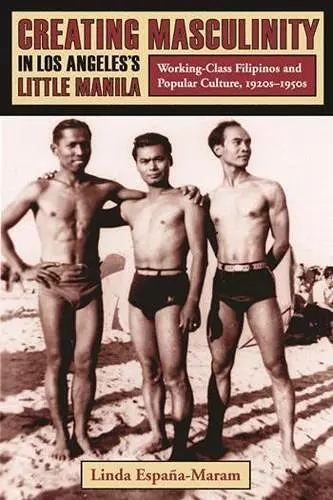Creating Masculinity in Los Angeles's Little Manila
Working-Class Filipinos and Popular Culture, 1920s-1950s
Format:Hardback
Publisher:Columbia University Press
Published:12th May '06
Currently unavailable, and unfortunately no date known when it will be back

In this bold and brilliant book, Espana-Maram offers us a new understanding of how history happens and why culture counts. Through lively, engaging, and empathetic accounts of a broad range of popular culture practices, Espana-Maram shows how seemingly trivial sites-like the dance floor, the boxing ring, and the gambling den-became unexpected sites of struggle for justice, dignity, recognition, and resources among immigrant male Filipino workers in Los Angeles in the 1930s and 1940s. The mutually constitutive nature of gender, class, and racial identities have never been more convincingly demonstrated than they are in this innovative, imaginative, and magnificently generative book. -- George Lipsitz, author of The Possessive Investment in Whiteness , University of California, Santa Cruz In this pathbreaking work, Espana-Maram locates the tensions of Filipino American immigrant masculinity within various spaces. She provides a stunning panoramic portrait that encompasses racial, ethnic, gender, sexual, and class strife and conflicts. A triumph of historical and cultural analysis. -- Martin F. Manalansan IV, associate professor of anthropology and Asian American studies, University of Illinois, Urbana-Champaign
Analyzes the experiences of Filipino men in Los Angeles's Little Manila, from the 1920s to the end of World War II. This book discusses Filipino boxers' challenge to white America's assumptions about race; the meanings behind zoot suit fashions; and taxi dance halls, where Filipino men crossed racial boundaries by dancing with Anglo women.In this new work, Linda Espana-Maram analyzes the politics of popular culture in the lives of Filipino laborers in Los Angeles's Little Manila, from the 1920s to the 1940s. The Filipinos' participation in leisure activities, including the thrills of Chinatown's gambling dens, boxing matches, and the sensual pleasures of dancing with white women in taxi dance halls sent legislators, reformers, and police forces scurrying to contain public displays of Filipino virility. But as Espana-Maram argues, Filipino workers, by flaunting "improper" behavior, established niches of autonomy where they could defy racist attitudes and shape an immigrant identity based on youth, ethnicity, and notions of heterosexual masculinity within the confines of a working class. Espana-Maram takes this history one step further by examining the relationships among Filipinos and other Angelenos of color, including the Chinese, Mexican Americans, and African Americans. Drawing on oral histories and previously untapped archival records, Espana-Maram provides an innovative and engaging perspective on Filipino immigrant experiences.
Espana-Maram's volume effectively conveys the multidimensional quality of these men's lives. -- Barbara M. Posadas Journal of American History [A] groundbreaking work. -- Philip Samponaro Journal of Popular Culture This book gives us a look into the lost world of Filipino American urban cultural creativity... an absorbing and exciting book. -- Dawn B. Mabalon H-Net [An] impressive, rewarding book. -- Whitney Strub Southern California Quarterly
- Winner of History Book Award 2006
ISBN: 9780231115926
Dimensions: unknown
Weight: unknown
280 pages